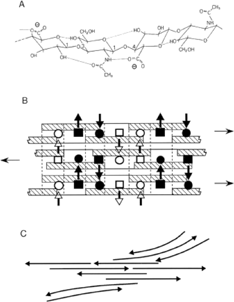Figures & data
FIG. 1 The primary, secondary, and tertiary structures of HA in solutions. (A) The primary structure of HA consists of repeating dissacharide units of D-glucoronic acid and N-acetyl-D-glucosamine with up to 5 hydrogen bonds existing between each two neighboring disaccharides. The secondary structures are formed as tape-like 2-fold helices by twisting each disacchride unit through 180° compared with those ahead and behind it in the chain. (B) The β -sheet tertiary structure tertiary structure is energetically stabilized by interactions between hydrophobic patches hatched and intermolecular hydrogen bonding between the acetamido ▪and □ and carboxylate groups (• and ○). (C) Schematic networks of HA molecules as a results of intermolecular aggregation (Reprinted with permission from Scott and Heatley Citation1999).

TABLE 1 Summary of the medical applications of HA
FIG. 2 The effect of 1% w/w polysaccharide on the percentage of applied diclofenac (1.75% w/w) delivered to the skin, 48 hr after application of the formulation (n = 4, mean ± standard deviation, *p < .001 compared with control).

TABLE 2 Summary of the drug delivery applications of HA